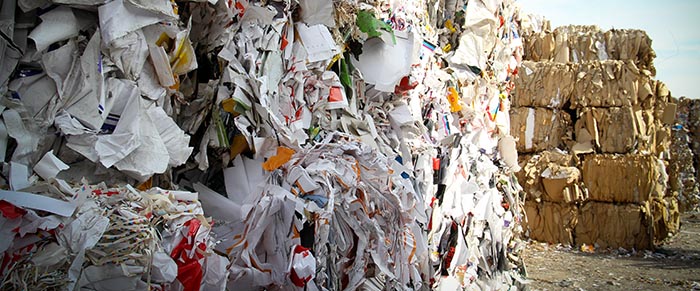In this guide, we will explore:
- What is recycled paper packaging?
- How is recycled paper turned into packaging products?
- Are recycled paper products better for the environment?
- How do recycled paper products stack up against alternatives?
What is recycled paper packaging?
In 2022, the paper recycling rate in the U.S. was nearly 68%. What's more is than 2/3 of the paper used in the U.S. is recycled and used to make new sustainable paper products that people use every day.
Recycling 1 ton of paper saves 17 mature trees, 7,000 gallons of water, 3 cubic yards of landfill space, and 380 gallons of oil, so there's good reason to recycle paper.
As more people shift from plastic food packaging to paper and recycled paper packaging, demand for recycled paper will increase. Considering that 4 billion trees are cut down every year to make new paper and paper products, this shift is an exciting change for sustainability-focused businesses and consumers.

How Is Recycled Paper Turned Into Packaging Products
So, what is the process of turning recycled paper into new paper packaging products such as cup sleeves, paper takeout boxes, napkins and paper bags?
The steps for recycling paper and giving it new life include:
1. Sorting the paper. Before paper can be given new life, recycling facilities must sort paper types for paper mills that use different grades of paper for different products. There are four primary categories:
- Kraft/corrugated paper (cardboard, packaging paper, paperboard)
- Newspaper
- High-grade paper
- Mixed papers
2. Pulping the paper. This process typically feeds sorted paper from a conveyor belt to a tank full of water and chemicals. Then it’s finely chopped and heated to break it into small strands of cellulose. The resulting mixture is called pulp.
3. Screening, cleaning, and de-inking. The pulp moves through screens that remove tiny contaminants and then is pushed through a cone to clean and remove any pollutants. It may also go through a de-inking process.
4. Color stripping, bleaching, and refining. Refining involves beating the pulp to ensure it’s in the best shape to be reconstituted. Color stripping is a chemical process to remove any colors from the pulp. Sometimes, the pulp is bleached with chlorine dioxide, hydrogen peroxide, or oxygen to make it whiter.
5. Making new paper. With the pulp now clean it is ready to be remade. The recycled fibers can be used on their own or can be combined with virgin fiber (new wood fiber) for extra strength.
The pulp is mixed with water and chemicals until the mixture is 99.5% water. The mixture is shot through a paper machine and sprayed onto a screen. The screen allows water to drain, so the fibers begin to bond together to form watery sheets of paper. Then, it moves through several foam-covered press rollers to continue the drying process.
Next it passes through heated rollers that dry out the paper before being wound into a huge roll weighing as much as 20 tons. This new 100% recycled paper can then be turned into new products.
Are recycled paper products better for the environment?
Recycled paper products are already preferred over plastics by environmental experts because trees are bio-based and renewable.
Recycled paper is also better for the environment than non-recycled paper products. In fact, for every ton of paper that’s recycled, 17 trees, 380 gallons of oil, 4,000 kilowatts of energy, three yards of landfill space, and 7,000 gallons of water are saved.
Recycled paper products tick all the boxes for being eco-friendly:
-
Recyclable – Paper can be recycled five to seven times on average, so even paper products that are already recycled can often be recycled again.
-
Biodegradable – Almost all paper can decompose naturally in six months or less.
-
Compostable – Most paper products are great for composting. In fact, "clean" cardboard can compost in around two months. Anything that’s glossy, heavily printed or covered in tape is not compostable.
-
Renewable – Trees are a renewable, natural resource. Most paper mills manage their own forests, and for each tree they cut down, they plant several more to ensure the growth rate stays stable and environmental impacts remain low. In fact, 4 million new trees are planted in the United States every day, and 1.7 million of those are planted by the wood and paper products industries.

The process of recycling paper also reduces carbon emissions in three distinct ways:
-
Decomposing paper in landfills creates methane so recycling eliminates these greenhouse gas emissions. If the demand for recycled paper and recycled paper packaging products increases, then the efforts to recycle paper could also increase.
-
Recycling paper saves trees, allowing them to absorb more CO2. Trees remove carbon from the atmosphere, so keeping more trees alive creates cleaner air.
-
Recycled paper requires less energy to manufacture than making paper out of wood. Producing recycled paper uses 60% less energy than virgin wood pulp paper production.
Environmentally speaking, using paper products made from recycled materials is a fantastic way to operate more sustainability.
How do recycled paper products stack up against alternatives?
If you’re considering upgrading your packaging to recycled paper products, you may be concerned about performance. At Good Start Packaging, we’ve taken strides to ensure our sustainable packaging can measure up to or outperform conventional paper products and even replace plastics and Styrofoam.
Our cup sleeves, paper takeout boxes, napkins and paper bags are all:
- Made from post-consumer recycled paper and/or FSC certified Paper
- Sourced to have the lowest environmental impact possible
- 100% compostable in 1-3 months in a commercial facility or 3-6 months in home composting
- Chlorine-free & PFAS-free
- Crafted according to FDA guidelines
Recycled paper packaging products can drastically reduce your company’s carbon footprint while maintaining the level of performance that your customers expect. Contact us to learn more about how we can help you meet your sustainability goals.





